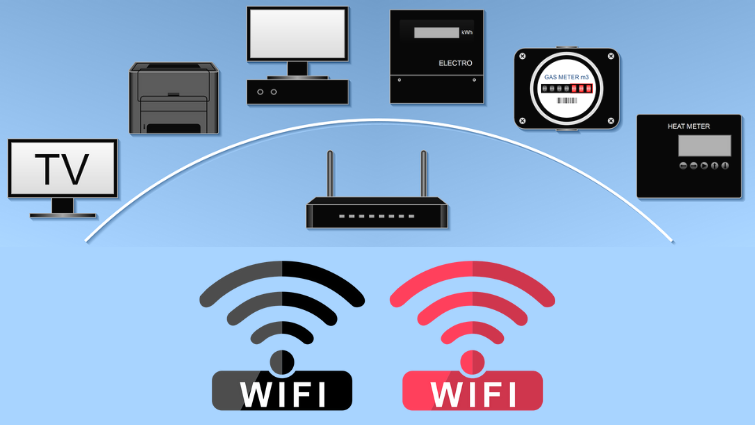The devices in your smart home need to communicate with each other. Sometimes, compatible devices talk to each other to synchronize behavior. They may also need to communicate with a central control unit or other devices such as your smartphone.
Smart devices communicate using protocols. These allow your home to automate functions such as locking your doors or shutting your blinds. Read on to find out about how these protocols work and what common protocols your home may use.
What Does a Smart Home Protocol Do?
A smart home protocol is the language that devices use to communicate with each other. This allows them to share information and control each other’s functions.
For any smart home device to function properly, it needs to be on the same network as its central hub or controlling unit. The protocols used today allow these devices and hubs to communicate with each other. They usually do so using a smartphone or computer.
While some smart home devices, like lights and plugs, don’t need a protocol to function, many do. For example, if you want to control your thermostat from your phone, you’ll need to use a protocol that your thermostat understands. Luckily, most popular protocols are cross-compatible. This means you can usually mix and match devices without many problems.
A few different protocols are available today. The five most common are Z-Wave, Z-Wave Long Range, ZigBee, Wi-Fi, Bluetooth Low Energy, and Thread. Let’s take a closer look at each of them.
Z-Wave
Z-Wave is one of the most popular open standard wireless communications protocols used for home automation. It uses mesh networking to relay messages between devices.
The protocol operates in the low-frequency 908.42 MHz in the United States. The low frequency allows it to penetrate walls much easier and eliminates interference with Wi-Fi.
Popular Z-Wave devices include door locks, thermostats, motion detectors, and security cameras. Home systems like Samsung’s SmartThings also work seamlessly with Z-Wave to communicate with smart devices.
The protocol supports up to 232 devices and includes 128-bit AES encryption, providing a high level of security. Its data transmission rate reaches a maximum of 100 kbps. This is more than enough for communication between typical Z-Wave devices.
Z-Wave Long Range
Z-Wave Long Range (Z-Wave LR) is a newer, more efficient way to communicate between devices on a Z-Wave network. The protocol was designed to promote increased scalability, battery life, range, and coverage.
The new protocol, like Z-Wave, follows fundamental principles of interoperability and compatibility. The network also operates at 912/920MHz, the same frequency as Z-Wave devices.
But unlike Z-Wave, which uses mesh typology, Z-Wave LR uses a star network topology. It also has a range of up to one mile.
With Z-Wave LR, a single smart home network can support up to 4,000 devices. The protocol also leverages a dynamic power control feature to offer up to 10 years of battery life on a coin-cell battery.
ZigBee
ZigBee is another open standard, wireless mesh network. The technology was developed with the unique needs of low-power, low-cost wireless, and Internet of Things (IoT) networks in mind.
The protocol supports data rates of up to 250 kbps and can operate in the 2.4 GHz frequency. It has strong interoperability capabilities with up to 65,000 devices per network. It also supports secure data transmission via AES-128 encryption, making it a great choice for complex smart home systems.
ZigBee is one of the main protocols used for many smart home hubs to control devices like lightbulbs, thermostats, and door locks. Alexa uses it, for example, to interact with smart devices in a home.
Wi-Fi
Wi-Fi has been a staple in our homes for quite some time now. Devices that run on Wi-Fi connect to the internet via your home router the same way your smartphones and computers do.
Wi-Fi allows you to connect devices such as smart TVs and refrigerators without extensive wiring.
The protocol uses 2.4GHz and 5 GHz, depending on the amount of data that devices send over it. Wi-Fi routers using the 2.4 GHz band can cover up to 150 feet indoors and 300 feet outdoors.
There are several different Wi-Fi protocols and data rates. Wi-Fi networks support some of the fastest smart home protocols. An 802.11a, for example, can reach a maximum speed of 54Mbps, while the 802.11b can achieve a speed of 11Mbps.
Setting up Wi-Fi is easy, and you don’t need a hub to connect to devices. The technology can be helpful in IoT apps that don’t have to worry about power drain or require a long range, such as a home security system.
Nest Wi-Fi routers also connect to most Wi-Fi-enabled smart home devices. In addition, a single Nest router connects up to 200 devices.
Bluetooth Low Energy
Bluetooth Low Energy (BLE) is a wireless protocol which uses much less power than traditional Bluetooth. The protocol supports mesh networking and uses AES-128 encryption for security.
Many operating systems support the protocol, including Android, iOS, Windows, macOS, and Linux.
BLE connects a wide range of IoT devices, from home appliances to smart grid meters and asset trackers. Devices such as wearable technology or fitness trackers can use it. BLE is convenient for use with coin-cell batteries that have a lifespan of many years.
The protocol uses microwave frequencies in the 2.4GHz ISM band to send data between devices. And, it’s most commonly used for sharing small amounts of data over relatively short distances (less than 100 meters).
Thread
Thread is an open standard, IPv6-based, low-power, mesh networking protocol. This makes it a great choice for homeowners who want to create a smart home without locking themselves into a specific ecosystem.
The Thread Group is a consortium that created the protocol. It includes Google Nest, Samsung, ARM Holdings, and other major technology companies.
Thread uses the IEEE 802.15.4 standard protocol, operates on the 2.4 GHz frequency, and can securely connect (using AES encryption) over 250 devices. This means enabled devices consume less energy and communicate faster.
At the moment, there are a limited number of devices that support Thread. But this is likely to change as the protocol becomes more popular. Some of the devices that currently support Thread include Nest thermostats and Yale locks.
Protocols Make Your Smart Home Work For You
The range of protocols available might make setting up your smart home sound like a daunting prospect. However, hubs can help your devices negotiate different protocols. Be sure to do your research and check device interoperability, paying careful attention to the protocols they support.


